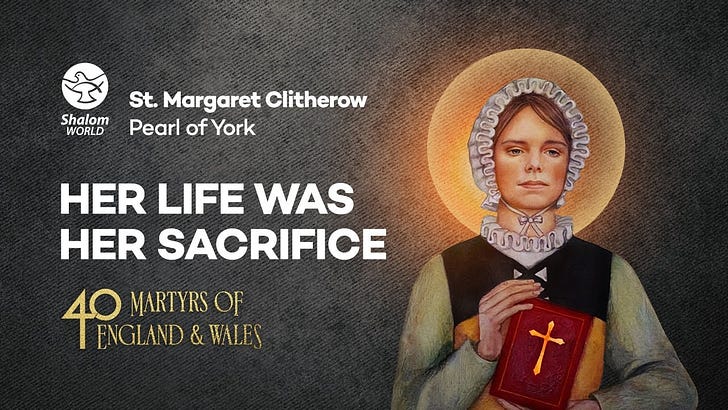Today is the Fourth Sunday of Lent, and if it were not a Sunday, it would have been the Feast of Saint Margaret Clitherow, Saint Anne Line and Saint Margaret Ward, three of the Forty Martyrs of England and Wales, martyrs of the English Protestant reformation. Each has their own story, and I am sure that we have looked at them individually, but the story of Margaret Clitherow is perhaps the best known. Her death, more than any other, demonstrates how vicious and cruel the persecution of Catholics was during this period.
This is an excellent video about her from Shalom World "All You Need to Know about St Margaret Clitherow/ Pearl of York/ Forty Martyrs of England and Wales"
Born in 1556 in York, Margaret Middleton was the daughter of the sheriff of York and church warden of St Martin’s Church in Coney Street. As a child, Margaret would have observed the state religion, Protestantism, and this religious affiliation seems to have continued until the early 1570s, at which point it seems that she was converted to Catholicism by the wife of Dr Thomas Vavasour, a prominent Catholic in York.
By this point, Margaret had married John Clitherow, a prosperous butcher who owned a shop on the Shambles. John was also responsible for reporting Catholic worshippers to the authorities who were, in line with the Elizabethan Settlement, Protestant. This would have almost certainly created tension in their marriage as Margaret began to subvert the authorities and the official church, a matter complicated by her decision to be a recusant (a non-church attender) in the years following her conversion.
The 1559 Injunctions which formed part of the Elizabethan Settlement had set the penalty for recusancy at 12d, a fee that John Clitherow had to pay for his wife’s perceived misbehaviour. It was for her recusancy that Margaret was first imprisoned in 1577. She was to be imprisoned twice more at York Castle with her final incarceration lasting for just short of two years. It was whilst imprisoned that Margaret learned to read Latin so that she could read and speak the Latin Mass. Margaret found the deaths of her fellow Catholics deeply troubling and so, upon her release, she went on a pilgrimage during the night to the gallows at Tyburn and Knavesmire where, between 1582 and 1583 five priests were hanged.
Margaret had succeeded in creating a concealed room in her home on the Shambles along with a secret cupboard in which she hid the priest’s vestments and wine and bread for the Mass, but failed to keep it secret, resulting in a frightened young boy revealing its location to the authorities when they raided her home in March 1586. Margaret was subsequently arrested for harbouring priests, something which had been made a criminal offence punishable by death in an Act of Parliament of 1581.
Margaret’s trial took place in the Guildhall but her refusal to be tried by a jury led to her automatically being sentenced to death. In a desperate attempt to persuade her to conform to trial by jury, the judges stressed the horrific barbarity of the assigned means of death for Margaret’s offence; being pressed to death. Yet, Margaret remained firm in her convictions and continued to refuse trial by jury, stating “I know of no offense whereof I should confess myself guilty. Having made no offence, I need no trial”.
Her refusal may have stemmed from her unwillingness to include others in the trial, as her friends and family would need to be questioned alongside her. Prior to her execution, visited by a friend in prison, Margaret remained faithful and eager to meet her Maker. She said to her friend,;
"The sheriffs have said that I am going to die this coming Friday; and I feel the weakness of my flesh which is troubled at this news, but my spirit rejoices greatly. For the love of God, pray for me and ask all good people to do likewise."
She was taken to the toll-booth on Ouse Bridge on Good Friday, 26 March 1586, and was pressed under seven or eight hundredweight (approximately eight hundred to nine hundred pounds) until she died roughly fifteen minutes later. Margaret left behind her husband and three children, whom Margaret had educated in the Catholic faith. Her son, Henry Clitherow, went abroad to train as a priest before returning to England as a missionary. Her other son William also became a priest, and her daughter Anne, a nun at St Ursula’s, Louvain.
Somewhat unusually, Elizabeth I herself seemed to condemn the killing of Margaret, writing a letter to the people of York which stated that Margaret should have been spared the terrible fate on account of her gender alone. It is also likely that she was pregnant at the time.
Margaret was Canonised by Pope Paul VI in October 1970 as one of forty English martyrs. It was Pope Paul VI who first called Margaret ‘the pearl of York. Bar Convent in York is said to possess a relic, supposedly the hand of Margaret Clitherow and there is a shrine to Margaret in St Wilfrid’s church, also located in York. Margaret’s house on the Shambles exists today as a shrine to this stoic woman and a plaque at the Micklegate end of the Ouse Bridge also commemorates the site of her execution.
Such a horrific story.



